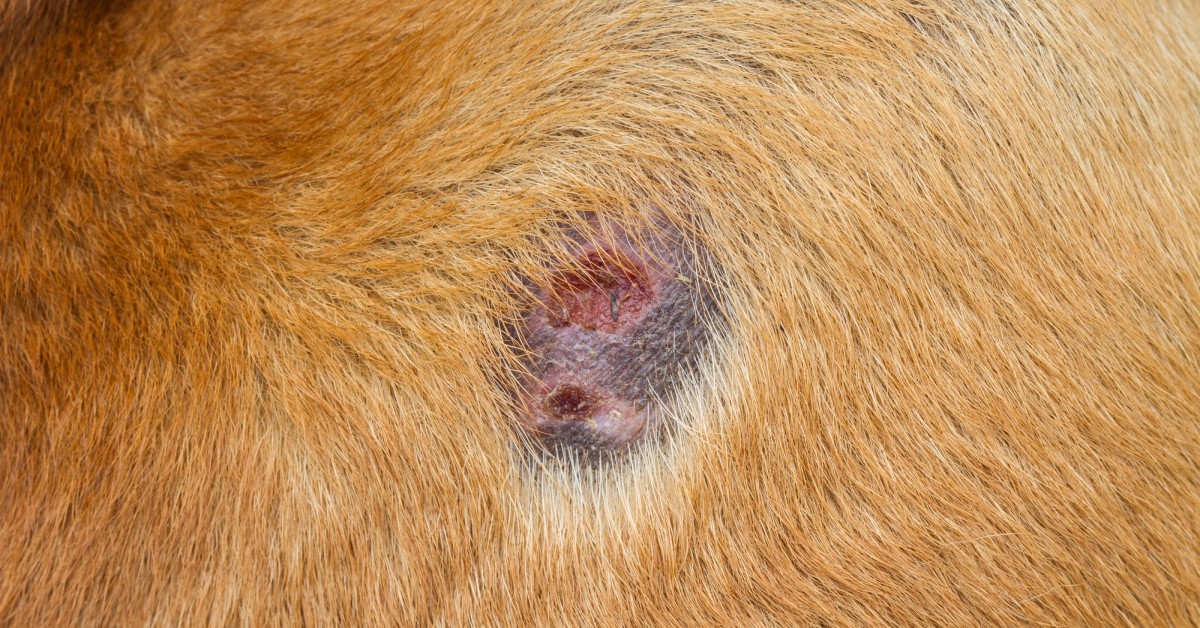Bacterial Skin Infections in Dogs
Dogs can develop skin infections when bacteria enter the body, resulting in skin redness, itchiness, and other uncomfortable symptoms.

Itchy, red, and inflamed skin in dogs is often a sign of a skin infection. Infections can develop when certain organisms, such as bacteria, enter the body through hair follicles or small breaks in the skin.
It’s not uncommon for a dog to develop a skin infection after getting an insect bite, burn, scrape, puncture, or other wound. These infections can affect virtually any part of the animal’s body, from the ears down to the paws.
The severity of a skin infection will depend on the type and how soon it’s treated, but can range from mild to severe. Let’s explore some of the most common bacterial skin infections in dogs and how they’re treated.
Pyoderma
Bacterial skin infections often present as secondary problems caused by underlying health conditions. Although many vets choose to treat the skin infection itself, it’s important to also consider what initial issue contributed to the problem and how to best manage it.
When it comes to canines, the most common bacterial skin condition is known as pyoderma. Pyoderma is a type of cutaneous infection with pus-forming bacteria, although the pus may not always be visible to the naked eye.
Pyoderma can be broken down into three main types:
Surface Pyoderma
This condition affects only the top layers of skin, leading to symptoms like redness, itching, and soreness. In some instances, a dog may experience an oozing of fluid that causes an oily appearance.
Surface pyoderma most commonly occurs within the folds of the skin or areas prone to moisture. Hot spots, which often develop due to self-trauma from a parasite or allergy, are a common type of surface pyoderma.
An overgrowth of bacteria can occur in areas that receive poor air ventilation or due to friction between skin surfaces.
Superficial Pyoderma
Superficial pyoderma goes deeper into the skin, causing more serious symptoms and discomfort. Once the condition reaches this level, “epidermal collarettes” are often spotted which occur when the superficial layers of skin begin to peel. This can occur anywhere on the body.
A common form of superficial pyoderma is known as folliculitis, an infection concentrated in and around the hair follicles. This condition is often characterized by pustules which appear as whiteheads around the follicles, as well as some redness and swelling. If disturbed, these pustules can rupture, leading to open wounds and eventually scarring.
Deep Pyoderma
Deep pyoderma is the most severe type and occurs when an infection penetrates deep into the skin. With this condition, you may see bumps developing that may drain. Fissures can occur that may ooze pus or other fluids. Some dogs may also have lesions that are itchy or painful.
If your pet develops deep pyoderma, you may find that it is complicated by other species of bacteria. This condition is most commonly associated with staphylococci and pseudomonas, E.
Most cases of pyoderma can be resolved with oral antibiotics and/or topical therapy. In cases where the condition is chronic or reoccurring, your vet may suggest additional testing to identify and treat the underlying condition that is contributing to the infection.
Staphylococcal
Staphylococcal is a common skin infection caused by the bacterium Staphylococcus sp., otherwise known as staph. The condition can be transmitted from dogs to humans and humans to dogs, meaning swift treatment is important to prevent the infection from spreading further.
While any dog can develop a staph infection, dogs with weaker immune systems are most susceptible, such as puppies and senior dogs. Some of the most common signs of staph infection in dogs include itchiness, fever, skin lesions, inflammation, lethargy, loss of appetite, coughing, and frequent or straining during urination.
Staph infections in dogs are typically treated with oral antibiotics, such as erythromycin, cephalexin, or clindamycin. Your vet may also prescribe an antibiotic ointment or shampoo to soothe your dog’s irritated skin.
Intertrigo
Intertrigo is a type of skin infection that develops in the skin folds. This condition is usually specific to dog breeds with short muzzles, such as English bulldogs, pugs, and French bulldogs.
As the skin folds rub together, it creates friction. This friction is often coupled with moisture, leading to irritation that can transform into an infection when bacteria is introduced to the area. Intertrigo is most common on the face, lips, tail, vulva, and other body folds.
Topical therapy is often recommended to treat intertrigo in dogs. However, in severe cases, the fold may need to be removed surgically to stop the infections from reoccurring.
Treatment for Skin Infections in Dogs
In the majority of cases, skin infections in dogs can be treated non-invasively with prescription medications. However, catching the condition early is key. It’s best to consult with your vet soon after you discover any new or unusual symptoms in your pet, such as crusty or scaly skin, pimple-like pustules, hair loss, ulcerated skin, or a change in odor.
Skin infections are generally easy to spot in animals and most prescription medications work quickly to eliminate the infection and clear the skin. With prompt treatment and vet care, your dog can recover quickly and reduce the likelihood of recurring infections or more serious conditions.
Ready to start saving money on pet wellness care?
Then take a look at Mint Wellness, the pet wellness plan that provides fast reimbursement on routine pet care. Save on vaccinations, wellness exams, preventatives, dental, and more!
Learn More


